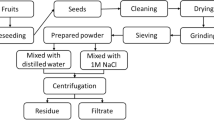Abstract
In this research, a plant material (Strychnos potatorum seed powder) has been used as natural coagulants, and tested the ability to remove turbidity from synthetic water and industrial water samples. The results from industrial water samples were compared with synthetic water samples. Experiments have been conducted in the laboratory to assess the percentage (maximum) of turbidity removal at various levels (i.e., 50, 80, 110, 120, and 145 NTU) from collected and prepared samples. Parameters influencing the coagulation mechanism such as dosage and pH were reported most suitable parameters for maximum turbidity removal. In this regard, the percentage of turbidity removal varies between 46–78% and 50–84% for synthetic and industrial water samples, at an ideal pH level (6–7) respectively. In addition, the isotherm model (i.e., Langmuir and Freundlich) was used to assess the sorption analysis from experimental data sets, wherein the monolayer sorption of contaminants onto the seed powder of S. potatorum was detected. The outcomes highlighted the effect of sorption in the turbidity removal percentage from both synthetic and industrial water samples, advocating the use of S. potatorum as a cost-effective alternative for industrial wastewater treatment.





Similar content being viewed by others
References
Adachi, Y., Kobayashi, A., & Kobayashi, M. (2012). Structure of colloidal flocs in relation to the dynamic properties of unstable suspension. Advanced Polymer Particles. https://doi.org/10.1155/2012/574878.
Adinolfi, M., Corsare, M. M., Lanzetta, R., Parrilli, M., Fplkard, G., Grant, W., et al. (1994). Composition of the coagulant polysaccharide fraction from Strychnos potatorum seeds. Carbohydrate Research, 263(1994), 103–110.
Chang, Y. S., Kim, J. H., Murugasan, K., Kim, Y. M., Kim, E. J., & Jeon, J. R. (2009). Use of grape seed and its natural polyphenol extracts as a natural organic coagulant for removal of cationic dyes. Chemosphere, 77, 1090–1098.
Choy, S. Y., Prasad, K. N., Wu, T. Y., Raghunandan, M. E., & Ramanan, R. N. (2002). Performance of conventional starches as natural coagulants for turbidity removal. Ecological Engineering, 94, 352–364.
Flaton, T. P. (2002). Aluminium as a risk factor in Alzheimer’s disease. Brain Research Bulletin, 55, 187–196.
Freundlich, H. M. F. (2012). Over the adsorption in solution. Journal of Physical Chemistry, 57(1906), 385–471.
Jahn, S. A. A. (1988). Using Moringa seeds as coagulants in developing countries. Journal of the American Water Works Association, 80, 43–50.
Langmuir, I. (1918). The adsorption of gases on plane surfaces of glass, mica and platinum. Journal of the American Chemical Society, 40, 1361–1368.
Liew, A. G., Noor, M. J. M. M., Muyibi, S. A., Fugara, A. M. S., Muhammed, T. A., & Iyuke, S. E. (2006). Surface water clarification using M. oleifera seeds. International Journal of Environmental Studies, 63, 211–219.
Madrona, G. S., Serpelloni, G. B., Vieira, A. M. S., Nishi, L., Cordoso, K. C., & Bergamasco, R. (2011). Study of the effect of saline solution on the extraction of the Moringa oleifera seed’s active component for water treatment. Water, Air, and Soil Pollution, 211, 409–415.
Martyn, C. N., Barker, D. J., Osmond, C., Harris, E. C., Edwardson, J. A., & Lacey, R. F. (1989). Geographical relation between Alzheimer’s disease and aluminum in drinking water. The Lancet, 8629, 59–62.
Muthuraman, G., & Sasikala, S. (2014). Removal of turbidity from drinking water using natural coagulants. Journal of Industrial and Engineering Chemistry, 20, 1727–1731.
Muyibi, S. A., & Evison, L. M. (1995). Optimizing physical parameters affecting coagulation of turbid water with Moringa oleifera seeds. Water Research, 29, 2689–2695.
Muyibi, S. A., & Evison, L. M. (1996). Coagulation of turbid water and softening of hard water with Moringa oleifera seeds. International Journal of Environmental Studies, 56, 483–495.
Muyibi, S. A., & Okufu, C. A. (2007). Coagulation of low turbidity surface water with Moringa oleifera seeds. International Journal of Environmental Studies, 48, 263–273.
Ndabigengesere, A., Narasiah, K. S., & Talbot, B. G. (1995). Active agents and mechanism of coagulation of turbid waters using Moringa oleifera. Water Research, 9, 703–710.
Okuda, T., Baes, A. U., Nishijima, W., & Okada, M. (2001). Coagulation mechanism of salt solution-extracted active component in Moringa oleifera seeds. Water Research, 35, 830–834.
Pillai, V. N. S., & Divakaran, R. (2002). Flocculation of river silt using chitosan. Water Research, 36, 2414–2418.
Pritchard, M., Craven, T., Mkandawire, T., Edmondson, A. S., & O’Neill, J. G. (2010). A comparison between Moringa oleifera and chemical coagulants in the purification of drinking water—An alternative sustainable solution for developing countries. Physics and Chemistry of the Earth, 35, 798–805.
Ramavandi, B. (2014). Treatment of water turbidity and bacteria by using a coagulant extracted from Plantago ovate. Water Resources and Industry, 6, 36–50.
Sharp, E. L., Parsons, S. A., & Jefferson, B. (2006). Seasonal variations in natural organic matter and its impact on coagulation in water treatment. Science of the Total Environment, 363, 183–194.
Sperczynska, E., Dabrowska, L., & Wisniowska, E. (2014). Removal of turbidity, colour and organic matter from surface water by coagulation with polyaluminium chlorides and with activated carbon as coagulant aid. Desalination and Water Treatment, 57, 1139–1144.
Yan, M., Wang, D., Yu, J., Ni, J., & Edwards, J. (2008). Enhanced coagulation with polyaluminum chlorides: Role of pH/alkalinity and speciation. Chemosphere, 71(2008), 1665–1673.
Acknowledgements
SG are thankful to Karunya Institute of Technology and Sciences Coimbatore, India for providing us the required funding and support during computer lab analysis.
Author information
Authors and Affiliations
Corresponding authors
Ethics declarations
Conflict of interest
The authors declare that there is no conflict of interest.
Additional information
Publisher's Note
Springer Nature remains neutral with regard to jurisdictional claims in published maps and institutional affiliations.
Rights and permissions
About this article
Cite this article
Gautam, S., Arora, A.S., Singh, A.K. et al. Coagulation influencing parameters investigation on textile industry discharge using Strychnos potatorum seed powders. Environ Dev Sustain 23, 5666–5673 (2021). https://doi.org/10.1007/s10668-020-00836-5
Received:
Accepted:
Published:
Issue Date:
DOI: https://doi.org/10.1007/s10668-020-00836-5




